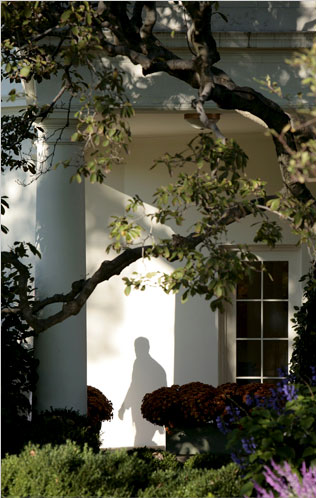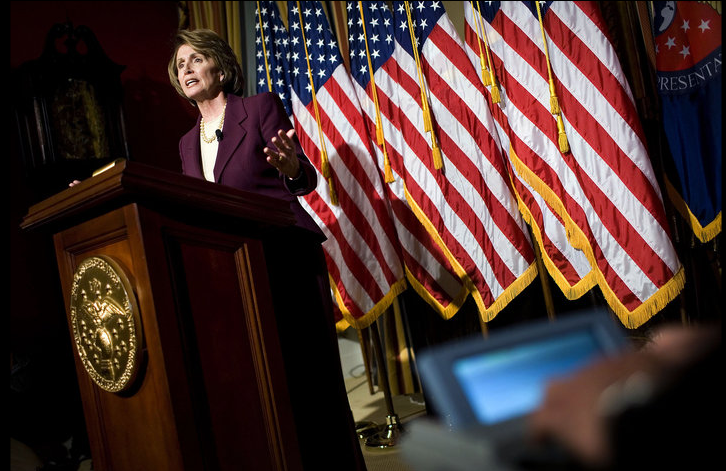Last week over at BAGnewsNotes Michael Shaw featured a picture of President Bush leaving the oval office in preparation for a trip to Southern California to “view the damage done by the wildfires in Southern California.” Difficult to see in the predawn shadows cast on the West Wing of the White House, but nevertheless physically present, the president is pictured in sharp contrast to the brightly lit window of the Oval Office through which we see Vice President Cheney who apparently has stayed behind to handle whatever everyday business might need tending to – say the war in Iraq. The photograph was a poignant comment on who might actually be running “the show” in Washington, D.C. these days. There was a time when the president would stay close to the Oval Office during times of crisis, and the vice president would function as the official emissary of the White House, but in this image the roles are clearly reversed.
I was reminded of that image when I saw the above photograph posted at the New York Times this past week. Once again the president is leaving the White House, this time on a trip to campaign for a Republican senate candidate and to visit troops graduating from boot camp at Fort Jackson, SC. And once again he leaves via the west portico of the White House in almost the exact location as in the previous picture. But there are important differences that deserve comment.
First, of course, this later image is taken not in the early morning hours when darkness still shrouds the White House and when one would hardly expect to see a great deal of pomp and circumstance as the president moves about. Rather, it is shot in the light of day, sometime in the early afternoon judging from the length of the shadows. And yet the president is completely alone – no entourage, no secret service, no military honor guard. Indeed, he appears to be slinking off in broad daylight – which may in fact be what he is doing given the gravity of national problems and the partisan, photo-op purposes of his trip. In this instance there are no lights on in the Oval Office—it is completely dark— and so it is hard to know if anyone is attending to business at all. The key difference between the two photographs, of course, is that here we don’t actually see the president, but rather his silhouette, a gossamer-like presence that recalls the flickering images in Plato’s cave. And notice too that his spectral stature, relative to the door he has just passed, suggests that the man casting the silhouette is a mere shadow of his appointed, presidential self, certainly not someone who is apparently up to rigors of his high office. No longer even just an emissary for the White House, here he is reduced to a shadowy existence that borders on political nothingness.
The salience of this most recent rendition of Lil’ Bush is emphasized by contrasting it with a photograph of Nancy Pelosi, the Speaker of the House, which appeared on the Washington Post website on the same day.
Shot at an oblique and low angle, the image catches the hint of an LED screen in the lower right corner, thus foregrounding the political theater being performed. Normally we might imagine this as a somewhat critical move, but notice how it distinguishes this image from the picture of the president. The image of the president is shot straight on and without any attention to the camera capturing the scene; it thus implies an ironic realism to the image that underscores the fact that this is not George Bush playing the role of being president, here he is off-stage, and … what you see is what you get. A mere shadow.
But there is more. For while the Speaker is the focal point of the image, her presence looms large relative to the ceremonially adorned rostrum at which she stands—and notice that she is speaking, literally acting out her role for the American people, and as the caption tells us, in defiance of the president’s threat to veto a revised version of the SCHIP —her physical body actually occupies only the left third of the screen. Behind her, and dominating the remaining two-thirds of the image is a bank of six American flags. The pomp and circumstance altogether absent in the Bush image (thus again emphasizing the realism of the image) is here in spades. And just left of center is the shadow of the Speaker cast on the screen of flags. Her shadow is smaller than she is (just like Lil’ Bush), but here it appears with economy and force, situating her visually where she might prefer to stand politically – acting in the name of the American people, in the full light of day (or at least in view of the media), and in a decisive but moderate stance, again, just left of center.
There are numerous points that could be made here, not least the extent to which those of us on the progressive Left should feel more or less uncomfortable with the second image and the ways in which it blends speaker and nation, visually understating the row of flags (which really do seem excessive) displayed as the source of national identification and authority. But for now I want to call attention to how the “shadow” can function differently as a conventional, visual marker of power and presence, at once minimizing or maximizing one’s stature, inviting either alienation or identification.
Photo Credits: Matthew Cavanaugh/European Pressphoto Agency; Joshua Roberts/Bloomberg News


[…] else? The shadow knows. We can look there for the form of a thing and so for what we might miss when distracted by all the […]